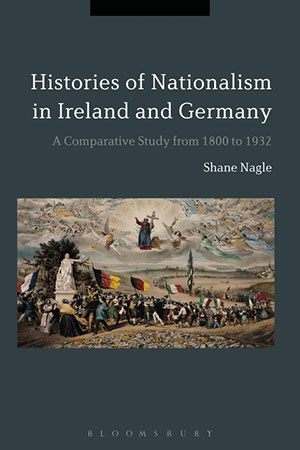Histories of Nationalism in Ireland and Germany: a comparative study from 1800 to 1932
Published in Book Reviews, Book Reviews, Issue 3 (May/June 2018), Reviews, Volume 26SHANE NAGLE
Bloomsbury
£91.80
ISBN 9781474263764
Reviewed by Angus Mitchell
 In 1954 the Cambridge historian Herbert Butterfield inaugurated the Wiles lecture series at Queen’s University, Belfast. In his opening address, titled‘The history of historiography’, he argued that German historians had much to answer for: ‘In their function of eliciting or discerning the essential traditions of their country they may have led their contemporaries astray’. Following on from this opinion, he went on to ask: ‘What has been wrong with the German historical school?’ Where schools of history go wrong is a concern that has long bemused those interested in the relationship of the past to the present, particularly in Ireland.
In 1954 the Cambridge historian Herbert Butterfield inaugurated the Wiles lecture series at Queen’s University, Belfast. In his opening address, titled‘The history of historiography’, he argued that German historians had much to answer for: ‘In their function of eliciting or discerning the essential traditions of their country they may have led their contemporaries astray’. Following on from this opinion, he went on to ask: ‘What has been wrong with the German historical school?’ Where schools of history go wrong is a concern that has long bemused those interested in the relationship of the past to the present, particularly in Ireland.
In this intense, comparative study of Irish and German historiography in the long nineteenth century, Shane Nagle explains much that might help us to find an answer to Butterfield’s question and to recognise the various agendas underscoring the politics of Irish history. The scale of the research is ambitious, the undertaking at once daring and compelling. By explaining how national identities speak to each other through historical practice and temporalities, Nagle bridges a critical divide within European intellectual history, drawing the Continental centre and the Atlantic periphery together.
Nagle’s analysis opens with the 1801Act of Union and the dissolution of the Holy Roman Empire in 1806 as Napoleon’s armies marched across Europe. The study ends in 1932, as the Nazi Party and Fianna Fáil rise to power. Many of the historians included in Nagle’s analysis were directly associated with the political developments of their time. While Germany, however, produced Leopold von Ranke, father of the modern history profession, Ireland was interpreted largely by ‘amateur’ historians.
What linked German and Irish historiography was the parallel search for continuity within a somewhat fragmented rendering of the past. Ireland was colonised not just by an ascendancy class but also by a history largely written from a British perspective. After the Famine, Irish nationalism was increasingly framed through opposition to the political economy of the British Empire and an assortment of Anglophobias ranging between the moderate and the extreme. German historians were concerned with developing avölkisch approach, a sense of unity based upon common beliefs among the people, critical before and after unification in 1871.
The book is divided into four thematic chapters—origins, religion, territory andrace—each one a cornerstone of nationalist thinking. Much consideration is given to the place of the medieval world as a way of mediating idealised vistas of the present and future,but that sense of medieval harmony was then interrupted by decline and fragmentation. The early modern period becomes a struggle for ‘liberty’ and union. The Reformation, the Thirty Years’ War and the 1641 depositions were particularly strong flashpoints for controversial interpretations. One key distinction is the fact that the nationalist history of Germany was largely perceived as a Protestant narrative, while in Ireland the story of independence is a predominantly Catholic one.
Of the sixteen historians listed in the biographical appendix, eight are German and eight are Irish,but the weight of analysis in the book overall seems to favour Ireland. There is only one woman in the list: Alice Stopford Green, elected as Britain’s first woman president of the Historical Association (1915–18) shortly after she had funded the running of guns into Howth and Kilcoole in July 1914. Was there ever a more conspicuous example of the crossing of the divide between historical practice and nationalist activism?This overall gender imbalance is not Nagle’s fault, however: in an on-line list of 60 nineteenth-century German historians, not a single woman figured.
In the final chapter Nagle looks at the transnational, and,while much of the analysis here is compelling, there is surely one critical oversight in the treatment of the Hiberno-German world. From the 1880s the Irish language became a rich field of interest for intellectuals, a curiosity driven by philologists and so-called ‘Celticists’ who studied and translated Irish texts. The vanguard of this movement was stimulated by German scholars such as Heinrich Zimmer, Ernst Windisch and, most notably, Kuno Meyer and Julius Pokorny. Their intervention was critical to the construction of a new sense of Irishness rooted in the identity politics of language. The scholar revolutionary Eóin MacNeill and the Gaelic League are central to that moment.Translation became a key component in the scripting of an Irish nationalist history and much of it was undertaken by German scholars. Nagle, however, reduces this confluence to little more than a footnote. Why? One reason,perhaps, is because post-1945 Ireland distanced itself from its intellectual connections to Germany.
Despite this omission,Nagle has madea formidable contribution to our reading of the history of European nationalisms and historiography. This work is highly stimulating and valuable, as much for its subtle polemics as for Nagle’s insights. His interpretation ultimately draws a distinction between history that is written to sustain the identity of a nation and history that becomes a required instrument of statecraft.It is perhaps in that partitioning of the past where some of the answer to Butterfield’s question lies.
Angus Mitchell lectures in history at the Kemmy Business School, University of Limerick.
















